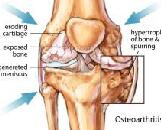Osteoarthritis (OA)
Ostarthritis; Ostearthritis; OA

Osteoarthritis is a type of joint disease that results from breakdown of joint cartilage and underlying bone. The most common symptoms are joint pain and stiffness. Other symptoms may include joint swelling, decreased range of motion, and when the back is affected weakness or numbness of the arms and legs. The most commonly involved joints are those near the ends of the fingers, at the base of the thumb, neck, lower back, knee, and hips. Causes include previous joint injury, abnormal joint or limb development, and inherited factors. Osteoarthritis is believed to be caused by mechanical stress on the joint and low grade inflammatory processes.
Studies showed that the presence of active collagenases 1 and 3 at OA lesion sites is consistent with an important role of these enzymes in the cartilage degradation of OA in guinea pigs. The expression of collagenase 3 in medial tibial cartilage from guinea pigs may signify a role of this enzyme in cartilage remodeling with growth and development, or it may represent an early molecular manifestation of OA.
Organism species: Mus musculus (Mouse)
- Disease model DSI587Mu02 Mouse Model for Osteoarthritis (OA) In Stock
- Disease model DSI587Mu03 Mouse Model for Osteoarthritis (OA) In Stock
- Customized Service n/a Tissue of Osteoarthritis (OA) (If Necessary) Tissue Customized Service Offer
- Customized Service n/a Serums of Osteoarthritis (OA) (If Necessary) Serums Customized Service Offer
Organism species: Rattus norvegicus (Rat)
- Disease model DSI587Ra01 Rat Model for Osteoarthritis (OA) In Stock
- Disease model DSI587Ra02 Rat Model for Osteoarthritis (OA) In Stock
- Disease model DSI587Ra03 Rat Model for Osteoarthritis (OA) In Stock
- Disease model DSI587Ra04 Rat Model for Osteoarthritis (OA) In Stock
- Disease model DSI587Ra05 Rat Model for Osteoarthritis (OA) In Stock
- Disease model DSI587Ra06 Rat Model for Osteoarthritis (OA) In Stock
- Tissue TSI587Ra75 Rat Tissue of Osteoarthritis (OA) In Stock
- Customized Service n/a Serums of Osteoarthritis (OA) (If Necessary) Serums Customized Service Offer
Organism species: Cavia (Guinea pig )
- Customized Service n/a Model for Osteoarthritis (OA) Disease Model Customized Service Offer
- Customized Service n/a Tissue of Osteoarthritis (OA) (If Necessary) Tissue Customized Service Offer
- Customized Service n/a Serums of Osteoarthritis (OA) (If Necessary) Serums Customized Service Offer
Organism species: Oryctolagus cuniculus (Rabbit)
- Disease model DSI587Rb01 Rabbit Model for Osteoarthritis (OA) In Stock
- Disease model DSI587Rb02 Rabbit Model for Osteoarthritis (OA) In Stock
- Disease model DSI587Rb03 Rabbit Model for Osteoarthritis (OA) In Stock
- Disease model DSI587Rb04 Rabbit Model for Osteoarthritis (OA) In Stock
- Disease model DSI587Rb05 Rabbit Model for Osteoarthritis (OA) In Stock
- Customized Service n/a Tissue of Osteoarthritis (OA) (If Necessary) Tissue Customized Service Offer
- Customized Service n/a Serums of Osteoarthritis (OA) (If Necessary) Serums Customized Service Offer
Organism species: Canis familiaris; Canine (Dog)
- Disease model DSI587Ca01 Canine Model for Osteoarthritis (OA) In Stock
- Disease model DSI587Ca02 Canine Model for Osteoarthritis (OA) In Stock
- Customized Service n/a Tissue of Osteoarthritis (OA) (If Necessary) Tissue Customized Service Offer
- Customized Service n/a Serums of Osteoarthritis (OA) (If Necessary) Serums Customized Service Offer


